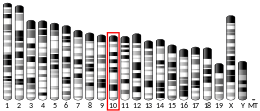RAB3IP
RAB3A-interacting protein is a protein that in humans is encoded by the RAB3IP gene.[5]
References
- GRCh38: Ensembl release 89: ENSG00000127328 - Ensembl, May 2017
- GRCm38: Ensembl release 89: ENSMUSG00000064181 - Ensembl, May 2017
- "Human PubMed Reference:". National Center for Biotechnology Information, U.S. National Library of Medicine.
- "Mouse PubMed Reference:". National Center for Biotechnology Information, U.S. National Library of Medicine.
- "Entrez Gene: RAB3IP RAB3A interacting protein (rabin3)".
Further reading
- Newport J, Roemer MI (1975). "Comparative perinatal mortality under medical care foundations and other delivery models". Inquiry : a journal of medical care organization, provision and financing. 12 (1): 10–7. PMID 123217.
- Brondyk WH, McKiernan CJ, Fortner KA, et al. (1995). "Interaction cloning of Rabin3, a novel protein that associates with the Ras-like GTPase Rab3A". Mol. Cell. Biol. 15 (3): 1137–43. doi:10.1128/MCB.15.3.1137. PMC 230335. PMID 7532276.
- Maruyama K, Sugano S (1994). "Oligo-capping: a simple method to replace the cap structure of eukaryotic mRNAs with oligoribonucleotides". Gene. 138 (1–2): 171–4. doi:10.1016/0378-1119(94)90802-8. PMID 8125298.
- Suzuki Y, Yoshitomo-Nakagawa K, Maruyama K, et al. (1997). "Construction and characterization of a full length-enriched and a 5'-end-enriched cDNA library". Gene. 200 (1–2): 149–56. doi:10.1016/S0378-1119(97)00411-3. PMID 9373149.
- de Bruijn DR, dos Santos NR, Kater-Baats E, et al. (2002). "The cancer-related protein SSX2 interacts with the human homologue of a Ras-like GTPase interactor, RAB3IP, and a novel nuclear protein, SSX2IP". Genes Chromosomes Cancer. 34 (3): 285–98. doi:10.1002/gcc.10073. PMID 12007189.
- Hattula K, Furuhjelm J, Arffman A, Peränen J (2003). "A Rab8-specific GDP/GTP Exchange Factor Is Involved in Actin Remodeling and Polarized Membrane Transport". Mol. Biol. Cell. 13 (9): 3268–80. doi:10.1091/mbc.E02-03-0143. PMC 124888. PMID 12221131.
- Strausberg RL, Feingold EA, Grouse LH, et al. (2003). "Generation and initial analysis of more than 15,000 full-length human and mouse cDNA sequences". Proc. Natl. Acad. Sci. U.S.A. 99 (26): 16899–903. doi:10.1073/pnas.242603899. PMC 139241. PMID 12477932.
- Ota T, Suzuki Y, Nishikawa T, et al. (2004). "Complete sequencing and characterization of 21,243 full-length human cDNAs". Nat. Genet. 36 (1): 40–5. doi:10.1038/ng1285. PMID 14702039.
- Gerhard DS, Wagner L, Feingold EA, et al. (2004). "The Status, Quality, and Expansion of the NIH Full-Length cDNA Project: The Mammalian Gene Collection (MGC)". Genome Res. 14 (10B): 2121–7. doi:10.1101/gr.2596504. PMC 528928. PMID 15489334.
- Rual JF, Venkatesan K, Hao T, et al. (2005). "Towards a proteome-scale map of the human protein-protein interaction network". Nature. 437 (7062): 1173–8. doi:10.1038/nature04209. PMID 16189514.
- Kimura K, Wakamatsu A, Suzuki Y, et al. (2006). "Diversification of transcriptional modulation: Large-scale identification and characterization of putative alternative promoters of human genes". Genome Res. 16 (1): 55–65. doi:10.1101/gr.4039406. PMC 1356129. PMID 16344560.
External links
This article is issued from Wikipedia. The text is licensed under Creative Commons - Attribution - Sharealike. Additional terms may apply for the media files.



